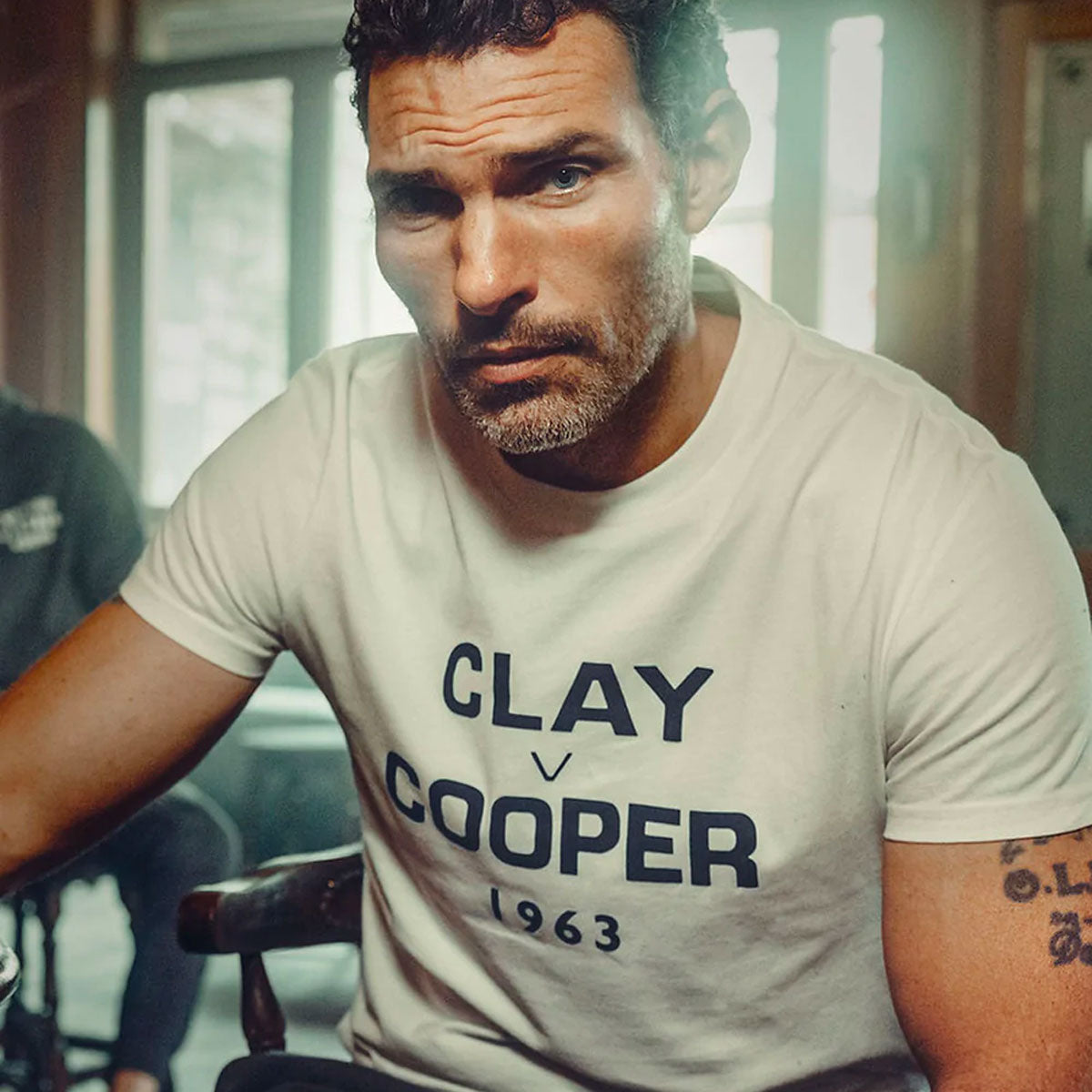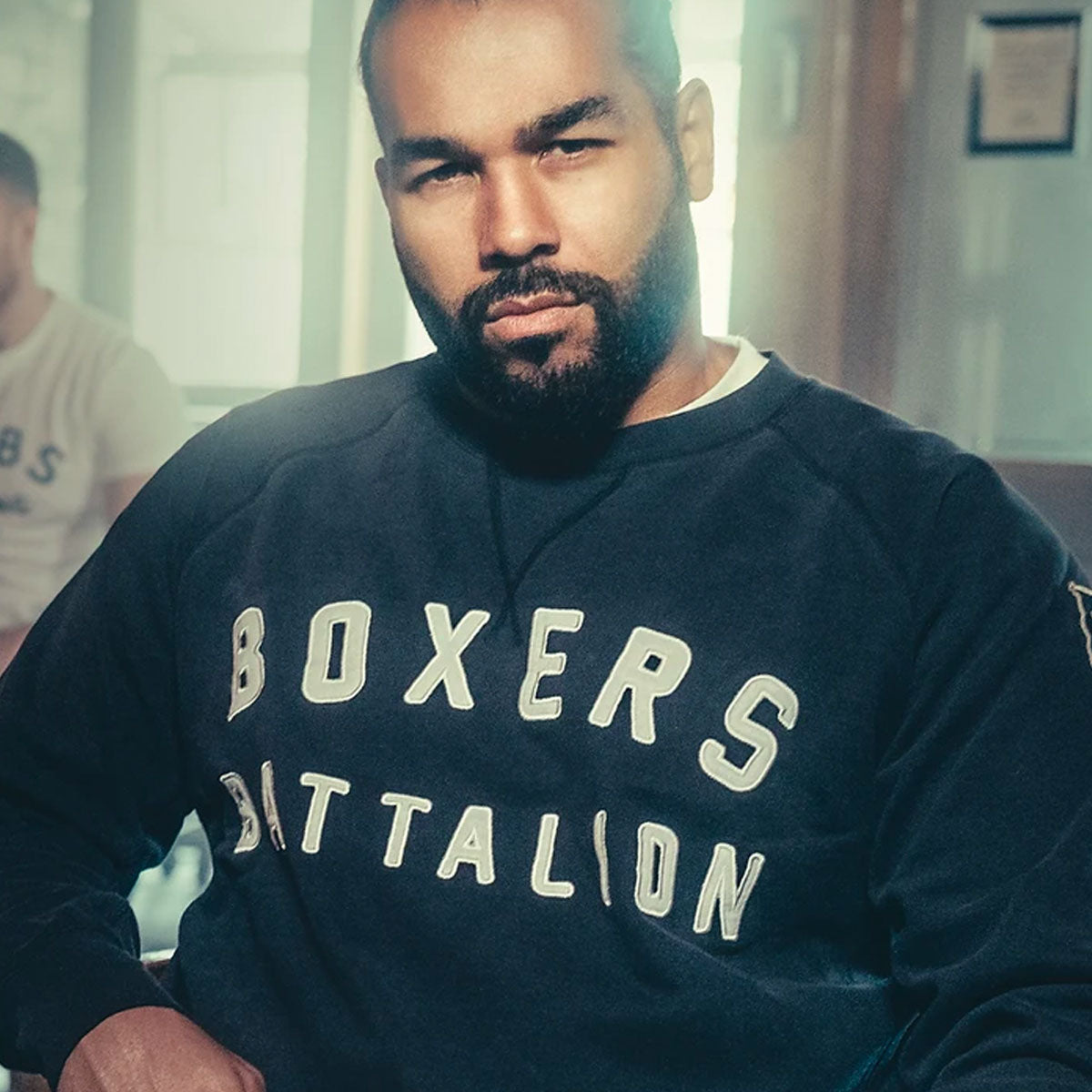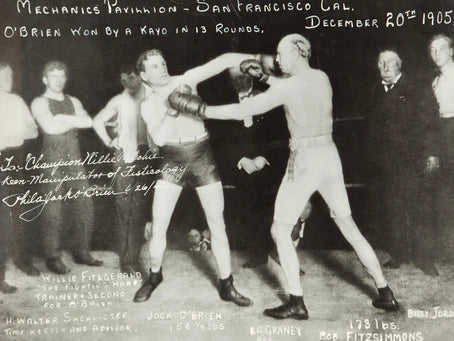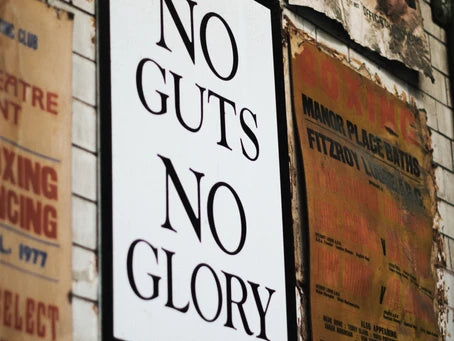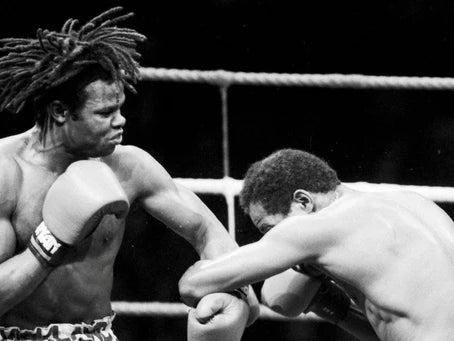Contributed by Paul Zanon
Bald, knobbly kneed, pale and often called ‘chicken legs’ due to the lack of muscle in his lower body, Bob Fitzsimmons hit like a mule’s kick and intimidated the most fearsome fighters of his era.
Robert James Fitzsimmons was the world’s first ever three weight world champion, claiming crowns from middleweight up to heavyweight. What makes the achievement even more impressive is that he achieved this pioneering accolade at a time when only eight weight divisions existed. At his prime, the 5ft 11inch champion weighed around the 12 stone mark, making him a modern day super middleweight. However, he possessed the punch power many heavyweights were envious of, as few of his foes rarely made it to the final bell. In fact, the late great founder of The Ring Magazine, Nat Fleischer, ranked Fitzsimmons as possibly the greatest knockout puncher of all time. ‘The bigger they are, the harder they fall,’ is a phrase attributed to Fitz. 
Born in Helston, Cornwall on 26 May 1863 (although some records believe his birth date was 4 June 1862), Fitzsimmons was born to parents James and Jane, alongside his six older brothers and five sisters. His mother’s maiden name was Strongman and young Robert certainly did the name proud over his lifetime.
In 1873, the Fitzsimmons family relocated 12,000 miles away to Timaru, on the South Island of New Zealand, where father, James set up a successful blacksmith’s forge. Learning the trade under his father’s watchful eyes, Fitzsimmons naturally developed incredible upper body strength by hammering iron. However, he also sharpened his orthodox tools as a boxer, initially under the guidance of his brother Jarrett.
After dabbling between gloved and bare knuckle fighting, Fitzsimmons’ official first roll of the fistic dice was in New Zealand’s first boxing tournament, hosted in 1880 by none other than British bareknuckle sensation, Jem Mace. Although only 18 years old, ‘The Fighting Blacksmith,’ who many simply knew as ‘Bob,’ or ‘Ruby Robert (due to his red hair),’ beat all four of his opponents and in doing so won the amateur championship of New Zealand. After repeating the feat the year after, successfully defending his amateur status, Fitzsimmons started to eye up the professional boxing scene.
After 13 straight stoppage victories in New Zealand, the Cornish born Kiwi resident had his official professional debut on 1 March 1885 in Sydney, Australia against Joe Riddle. Fighting a further 41 times ‘Down Under,’ over the next five years, Fitzsimmons boasted a record of 19 wins, 6 draws, 12 losses and five no-contests. Hardly the resume of a future multi weight world champion. 
On 17 May 1890 Bob travelled Stateside, beating Californian, Frank Allen in San Francisco. This would be the start of a very fruitful era for Fitzsimmons, in terms of wins, titles and defining fights. Also, many believed he received the rough end of the stick as a Kiwi fighting in Australia, whereas he was judged on his merits in America.
Three fights later, on 14 January 1891, Fitzsimmons fought Jack ‘Nonpareil’ Dempsey for the world middleweight title. The contest was attended by 4,500 thousand people, as they watched Fitzsimmons knock down his rival over 10 times, while Fitz kept pleading with Dempsey to quit, due to the beating he was taking. After continually refusing, he knocked him out in the thirteenth session and gallantly carried Dempsey to his corner. In addition to earning his first world strap, he also picked up a handsome $11,000 payday for his troubles. Soon after, he vacated the title and was on a mission to campaign at the next division up, heavyweight, as the light heavyweight division did not evolve until 1903. Despite on occasions being outweighed by almost 100 lbs, his will to win was insatiable.
However, on 16 November 1894, Fitzsimmons life could have taken a dramatic change. After knocking out sparring partner Con Riordan during a public exhibition at Jacob’s Opera House, Syracuse, New York, the Irish born boxer tragically died a few hours later. A couple of months down the line Fitzsimmons was charged with manslaughter, but was later acquitted.
Since his U.S. debut, Fitzsimmons did not lose a single fight in 36 contests. Adversaries along the way included teak tough light heavyweight, Joe Choynski and Bill Hall. On 2 December 1896, Fitzsimmons luck changed as he locked horns with Tom Sharkey for the world heavyweight title. Although records show a loss on Fitzsimmons record against Sharkey, it was a debatable decision to say the least. The bout, promoted as a world heavyweight title contest, declared Sharkey the victor via eighth round disqualification after claiming a low blow from a clear shot to the solar plexus. Those in attendance showed their instant distain to the decision, believing it was a fix, while Sharkey was carried off to nurse his pride and midriff. The referee to make the decision notorious gunslinger, Wyatt Earp, who walked into the ring armed with his Colt .45. One can imagine those in the crowds did not air their grievance directly to Earp.
Not one to rest on his laurels, Fitzsimmons bounced back, taking on the world heavyweight champion, James J. Corbett on 17 March 1897 at The Race Track Arena, Carson City. Corbett had beaten the first ever gloved heavyweight champion in John L. Sullivan on 7 September 1892, was two inches taller than Fitzsimmons and weighed 17 lbs more on entering the ring. The odds were not stacked in Fitzsimmons favour.
Weighing in at a mere 167lbs, one pound below the modern day super middleweight limit, Fitzsimmons was knocked down by Corbett in the sixth session, was being outboxed and his face certainly earned him the ‘Ruby’ moniker as it continued to absorb the full extent of Corbett’s punch repertoire. Being the heavier man, Corbett must have assumed he could dispose of Fitz in quick fashion, but he assumed wrongly. As Corbett tired, Fitzsimmons grew in strength and confidence, landing his trademark solar plexus punch in the fourteenth round, rendering Corbett unfit to continue. He was now the heavyweight champion of the world and a two weight world champion.
Unfortunately, two fights later, on 9 June 1899, ‘The Boilermaker,’ Jim Jeffries, challenged ‘The Fighting Blacksmith,’ for his crown. Jeffries, a natural heavyweight, outweighed Fitzsimmons by 39lbs, entering the ring at 206lbs of solid muscle. Despite a valiant attempt to retain his title, Fitzsimmons was stopped in the eleventh round. After winning five successive contests by stoppage and even writing and publishing a book in 1901 entitled, ‘Physical Culture and Self-Defence,’ Fitzsimmons challenged Jeffries again, in an attempt to regain his crown. Unfortunately, he was stopped in round eight on 25 July 1902. The battling blacksmith was not done yet though.
Over the next 10 months, Fitzsimmons beat four opponents, including Italian born American, Joe Grim, earning him a shot at the light heavyweight world title. On 25 November 1903, Fitzsimmons took on the reigning champion, George Gardner at The Mechanic’s Pavilion, Pennsylvania. After 20 hard fought rounds, Fitzsimmons was declared the new light heavyweight champion and had made history as the first three weight world champion at the age of 40. 
A couple of fights later, Fitzsimmons moved back up to fighting heavyweights, including a certain Galveston Giant by the name of Jack Johnson, who stopped Fitz in the second session on 17 July 1907. Fighting a further three times, Fitzsimmons last fight was on 20 February 1914, against Jersey Bellew in South Bethlehem, Pennsylvania.
Despite being proud of his Cornish roots, Fitzsimmons never fought on England’s green pastures. He was eccentric to say the least, owning pet lions called Nero and Senator Reynolds, with Nero often sleeping in the same bed with Fitz. He also dabbled with a few acting appearances on Broadway. Sadly, he passed away from pneumonia on 22 October 1917, in Chicago at the age of 54. He was survived by his fourth wife.
Record keeping for Fitzsimmons bouts vary somewhat, with some sources stating he fought 80 contests, whereas others believe he had as many as 125. Either way, one thing was consistent – his knockout ratio. Losing only about a dozen fights, he stopped around 90% of opponents. In 2003 Ring Magazine ranked him as the eighth biggest puncher of all time.
Should you wish to rub shoulders with Bob Fitzsimmons, a statue of champ stands on the corner of Stafford and Strathallan Streets in Timaru. It was commissioned by property tycoon, Bob Jones, sculptured by Margriet Windhausen and formally unveiled by the Prime Minister of New Zealand, David Lange on 5 September 1987.
He was inducted into the New Zealand Sports Hall of Fame in 1995 and the International Boxing Hall of Fame made him a member of its Old Timers. Bob’s memory lives on.
Paul Zanon, has had nine books published, with almost all of them reaching the No1 Bestselling spot in their respective categories on Amazon. He has co-hosted boxing shows on Talk Sport, been a pundit on London Live, Boxnation and has contributed to a number of boxing publications, including, Boxing Monthly, The Ring, Daily Sport, Boxing News, Boxing Social, amongst other publications.


